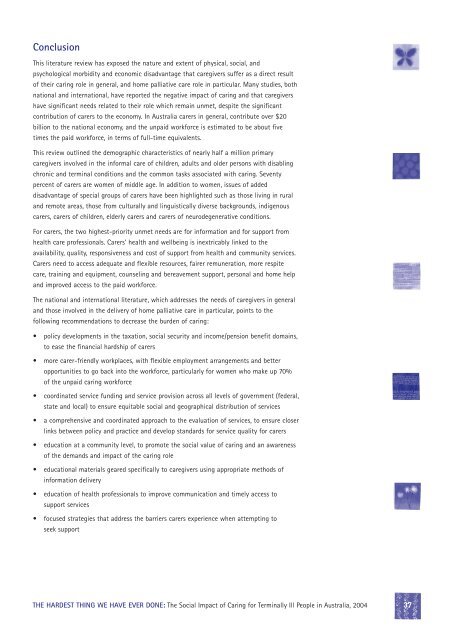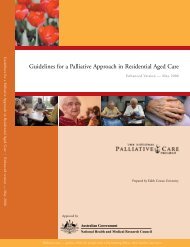The hardest thing we have ever done - Palliative Care Australia
The hardest thing we have ever done - Palliative Care Australia
The hardest thing we have ever done - Palliative Care Australia
You also want an ePaper? Increase the reach of your titles
YUMPU automatically turns print PDFs into web optimized ePapers that Google loves.
Conclusion<br />
This literature review has exposed the nature and extent of physical, social, and<br />
psychological morbidity and economic disadvantage that caregivers suffer as a direct result<br />
of their caring role in general, and home palliative care role in particular. Many studies, both<br />
national and international, <strong>have</strong> reported the negative impact of caring and that caregivers<br />
<strong>have</strong> significant needs related to their role which remain unmet, despite the significant<br />
contribution of carers to the economy. In <strong>Australia</strong> carers in general, contribute over $20<br />
billion to the national economy, and the unpaid workforce is estimated to be about five<br />
times the paid workforce, in terms of full-time equivalents.<br />
This review outlined the demographic characteristics of nearly half a million primary<br />
caregivers involved in the informal care of children, adults and older persons with disabling<br />
chronic and terminal conditions and the common tasks associated with caring. Seventy<br />
percent of carers are women of middle age. In addition to women, issues of added<br />
disadvantage of special groups of carers <strong>have</strong> been highlighted such as those living in rural<br />
and remote areas, those from culturally and linguistically diverse backgrounds, indigenous<br />
carers, carers of children, elderly carers and carers of neurodegenerative conditions.<br />
For carers, the two highest-priority unmet needs are for information and for support from<br />
health care professionals. <strong>Care</strong>rs’ health and <strong>we</strong>llbeing is inextricably linked to the<br />
availability, quality, responsiveness and cost of support from health and community services.<br />
<strong>Care</strong>rs need to access adequate and flexible resources, fairer remuneration, more respite<br />
care, training and equipment, counseling and bereavement support, personal and home help<br />
and improved access to the paid workforce.<br />
<strong>The</strong> national and international literature, which addresses the needs of caregivers in general<br />
and those involved in the delivery of home palliative care in particular, points to the<br />
following recommendations to decrease the burden of caring:<br />
• policy developments in the taxation, social security and income/pension benefit domains,<br />
to ease the financial hardship of carers<br />
• more carer-friendly workplaces, with flexible employment arrangements and better<br />
opportunities to go back into the workforce, particularly for women who make up 70%<br />
of the unpaid caring workforce<br />
• coordinated service funding and service provision across all levels of government (federal,<br />
state and local) to ensure equitable social and geographical distribution of services<br />
• a comprehensive and coordinated approach to the evaluation of services, to ensure closer<br />
links bet<strong>we</strong>en policy and practice and develop standards for service quality for carers<br />
• education at a community level, to promote the social value of caring and an awareness<br />
of the demands and impact of the caring role<br />
• educational materials geared specifically to caregivers using appropriate methods of<br />
information delivery<br />
• education of health professionals to improve communication and timely access to<br />
support services<br />
• focused strategies that address the barriers carers experience when attempting to<br />
seek support<br />
THE HARDEST THING WE HAVE EVER DONE: <strong>The</strong> Social Impact of Caring for Terminally Ill People in <strong>Australia</strong>, 2004<br />
37
















